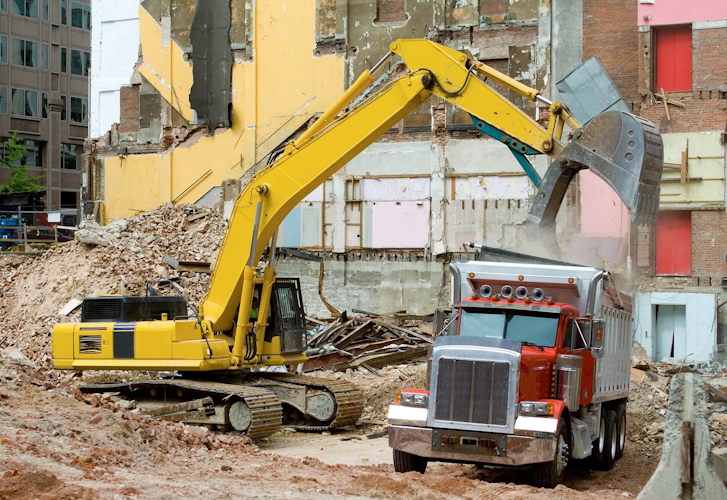Limit Pollution and Stay Healthy
Learning about your dumpster rentals and waste management
Home - Dumpster Rentals - Demolition Done Right: Essential Safety Tips for a Secure Worksite
Demolition Done Right: Essential Safety Tips for a Secure Worksite
Posted on March 1, 2024 in Dumpster Rentals

Carrying out demolition work safely: what to do
Demolishing a house in Texas is a complex task that requires careful planning and precise execution to ensure the safety of workers, neighboring residents and the environment. When it comes to safely carrying out a house demolition, it is essential to follow strict procedures, use appropriate equipment and respect current safety regulations. And let’s not forget to mention waste management issues, as all the construction debris must be removed!
Initial site assessment
Before undertaking the demolition of a house, it is imperative to carry out a complete assessment of the site. This includes inspecting existing structures, identifying potentially hazardous materials such as asbestos, and checking environmental conditions. A careful assessment allows you to design a precise demolition plan, taking into account all possible risk factors.
For a precise evaluation of your project, you can contact a company specializing in this field.
Obtaining the necessary local authorizations
Before starting demolition work, it is crucial to obtain all necessary permissions from local authorities. This often includes demolition permits, environmental permits, and other area-specific approvals.
Ensuring regulatory compliance from the outset is essential to avoid costly delays and legal complications later. Your demolition project can therefore continue with complete peace of mind.
Selection of appropriate equipment
The choice of demolition equipment is a critical step to ensure the safety of the process. Appropriate demolition equipment, such as backhoes, jackhammers and controlled explosives, should be selected based on the size and structure of the house.
Equipment operators must be trained and certified to ensure safe and efficient use. Naturally, these operators must also wear personal protective equipment. This avoids accidents during work.
Site preparation
Before commencing actual demolition, it is necessary to prepare the site appropriately. This includes the establishment of security barriers to restrict access to unauthorized persons, the disposal of hazardous waste as well as the protection of neighboring infrastructure. Proper site preparation helps minimize potential risks and ensure job site safety.
Waste Management Services
The management of waste from demolition is an essential component of the process. Materials such as wood, metal, concrete and other debris should be sorted and disposed of responsibly. Some materials can be recycled, helping to reduce the environmental impact of demolition. Hazardous waste must be disposed of in accordance with regulatory standards.
After the demolition is completed, effective waste management is crucial for environmental sustainability and public safety. The process involves sorting, recycling, and disposing of various materials generated from the demolition site. Concrete, bricks, and metals are often salvaged for recycling, reducing the burden on landfills and conserving resources. Hazardous materials like asbestos must be carefully handled and disposed of according to regulations to prevent health risks, possibly using dumpster rental services.
Proper waste management also involves controlling dust and debris to minimize air and water pollution. This may include using water sprays, barriers, and covering materials during demolition and cleanup. Additionally, waste management plans should prioritize the reuse of materials whenever possible, promoting a circular economy and reducing the need for new resource extraction.
Community engagement plays a vital role in waste management post-demolition, ensuring local residents are informed about disposal procedures and potential hazards. By implementing comprehensive a waste management planning, a demolition project can minimize its environmental footprint and contribute to a cleaner, safer future.
Dust and emissions control
Demolition can generate significant amounts of dust and potentially harmful emissions. It is imperative to adopt adequate control measures, such as using water sprayers to reduce dust and installing filters on equipment to limit emissions. These precautions help preserve the quality of the surrounding air.
Continuous monitoring
Throughout the demolition process, continuous monitoring is necessary to quickly detect and resolve any potential problems. This includes vibration monitoring, waste management, and checking the stability of remaining structures. Regular communication between members of the demolition team is also crucial to ensuring the overall safety of the construction site.
Carrying out a safe house demolition requires careful planning, precise execution and strict adherence to safety standards. Through a thorough initial assessment, obtaining necessary permits, selecting appropriate equipment, site preparation, waste management, dumpster rentals, emissions control and ongoing monitoring, it is possible to accomplish safe demolition while minimizing risks to people and the environment. By following these steps, demolition professionals can guarantee the success of the project while preserving the safety and health of everyone involved.
 I try my best to only publish information that is 100% verified and scientifically proven.
I try my best to only publish information that is 100% verified and scientifically proven.